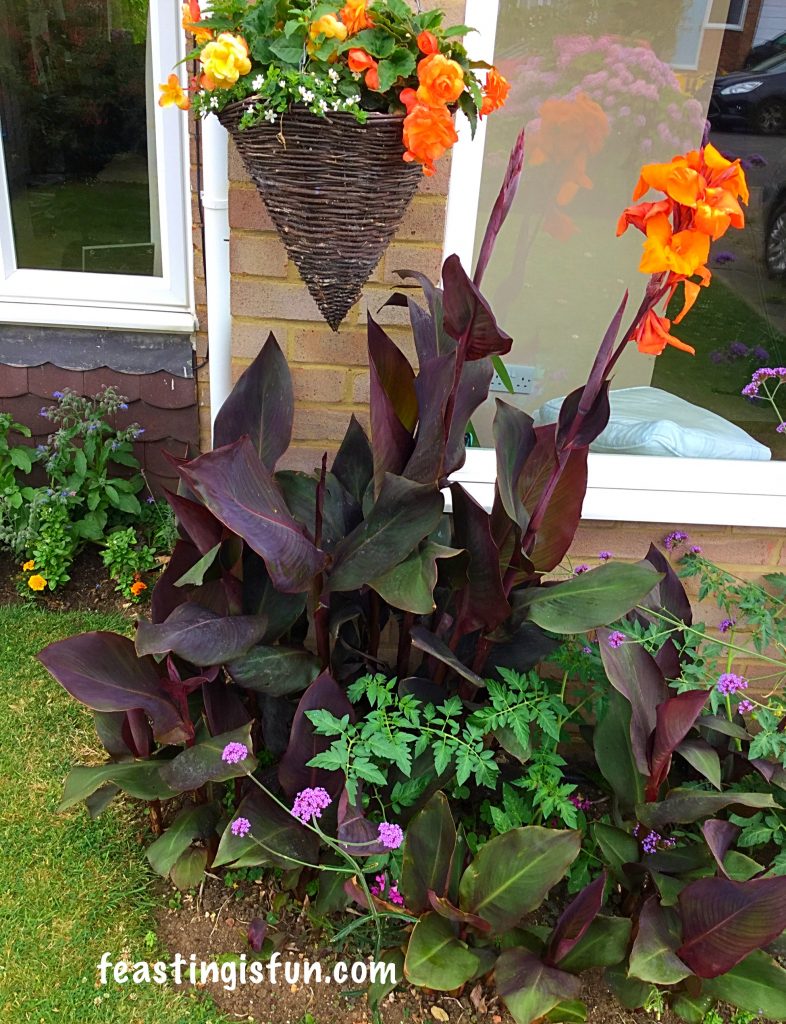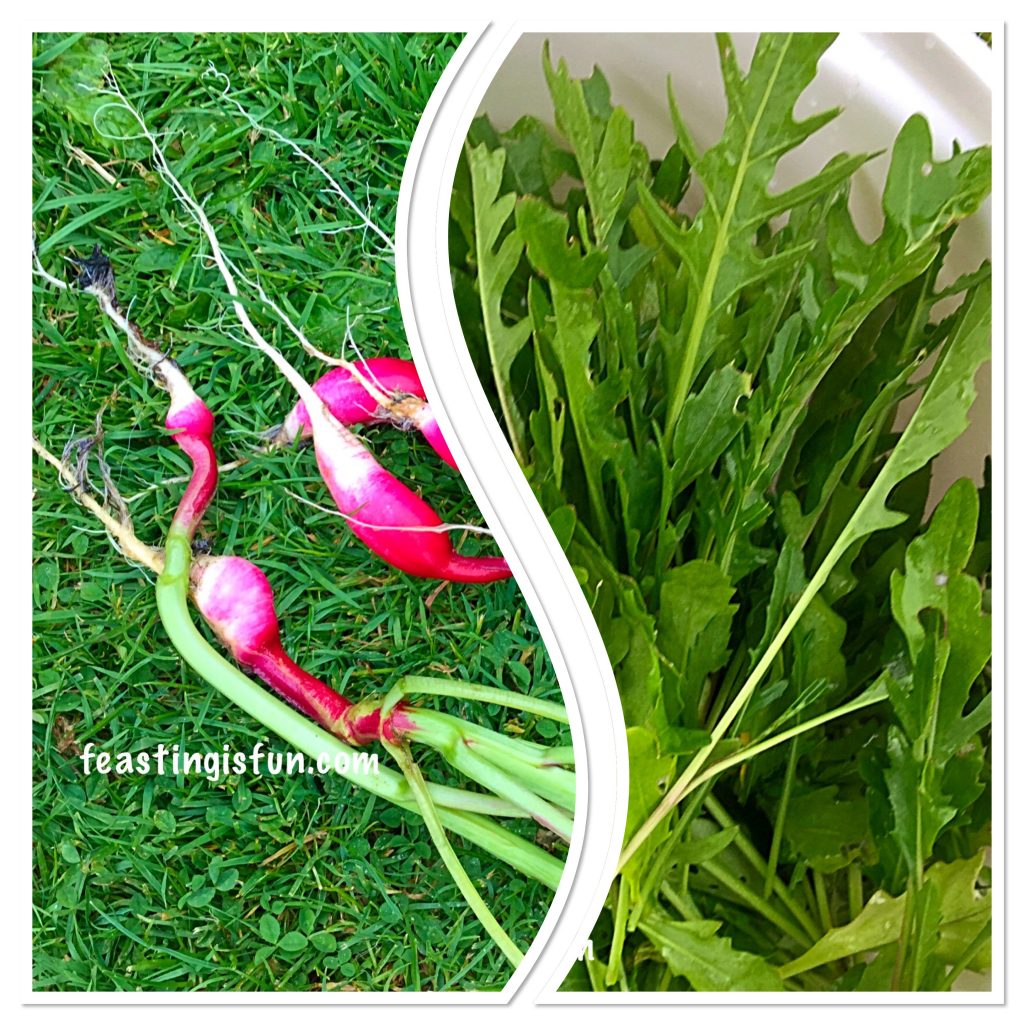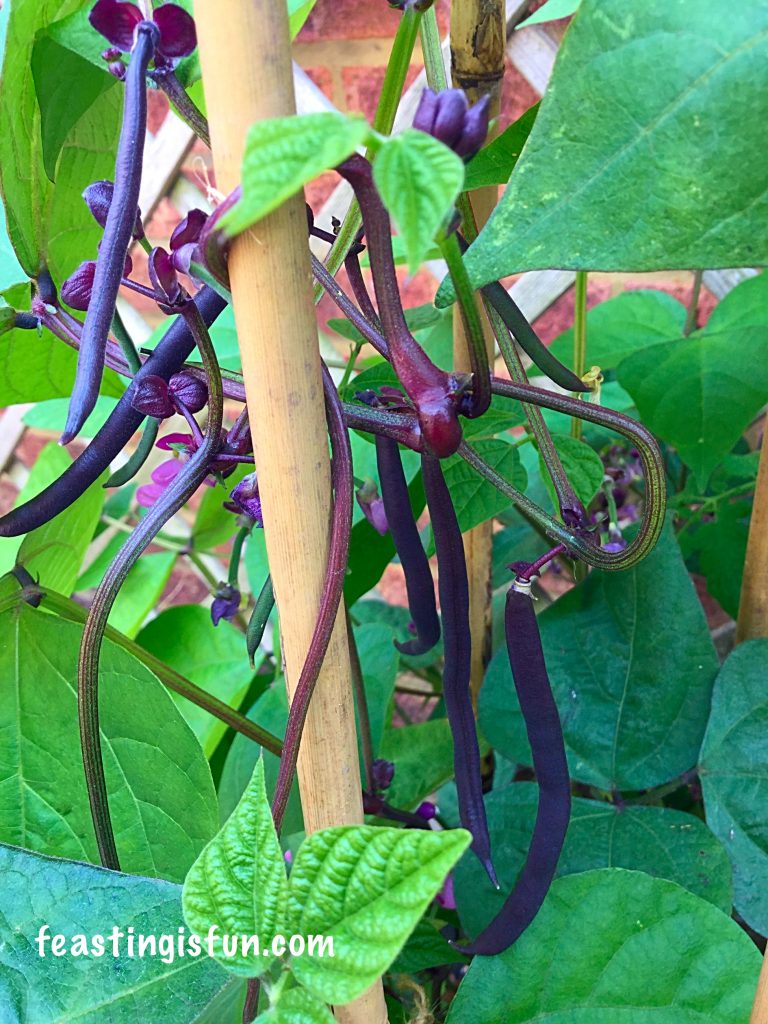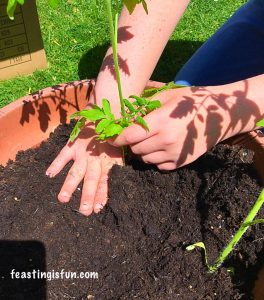Welcome to Growing Vegetables Week 5 with Bob and Sammie. This past week has been very exciting as we have taken on a new experiment, more on that later and we are also starting to harvest courgettes! Enjoy reading about our adventures in the garden.

It was such a thrill to capture the shot of the bee happily pollinating our courgettes. Bee’s and other pollinators are vital to the success of our vegetable growing adventure. Without them the Gartenpearle tomatoes you see below, sown from Groseeds seed, would not be forming, in fact none of our vegetable flowers would produce fruit.

It is true, some vegetables are wind pollinated. Sweetcorn is the first one that springs to mind. They are grown in blocks so that as the wind blows, it blows the pollen from one plant to another. We are hoping to grow sweetcorn next year.
I love seeing the bees, butterflies and hover flies, not forgetting moths our nighttime friendly pollinators. Bob and I were also really pleased to spot a couple of frogs, hiding in the damper parts, behind the plants, as we were gardening this week. We have not had a problem with slugs or snails for a while now, so all the new plants we potted up this week have not had any slug pellets on them.
Any slug pellets that were used earlier in the season were at a height where the frogs could not get them. Whilst trying to grow as organically as we can, our garden was full of snails, hiding in and under containers. We manually dispatched as many of them as we could, however, all of our efforts to grow our our vegetables would have been in vain, had we not used slug pellets on the first seedlings. Now we have fewer snails and are happy for frogs and hedgehogs to munch on them.
Yes we have some snail damage on our plants, but we can live with that!

After initial concerns that our runner beans weren’t setting – due to the hot weather – I was pleased to see these two baby ones this morning. Painted Lady, the variety we are growing, have always been reliable in both containers and the ground. A good straight bean that isn’t stringy! I definitely recommend them. We will be sowing a second lot, straight into the pot for runner beans into Autumn.

Chilli, borage, basil which is flowering, all in the front garden and settled. Lots of bees were buzzing around as I took the above photo.
A quick update on jobs carried out this week before I tell you about our exciting experiment:
- Lettuce/Wild Rocket/Radishes that had bolted and run to seed – tubs emptied on to the compost heap. We are hoping to sow more over this weekend.
- Picking courgettes as soon as they are 3 inches long. This helps increase the yield from each plant and stops enormous marrow-like monsters that are tasteless and reduce yield. Also whilst checking over the courgettes we remove fallen flowers and yellowing leaves – this prevents mould from forming and spreading.
- Picking ripe long beans, our variety is Purple Queen and they are going to be eaten with dinner tonight!
- Daily watering – we have had very little rain since before the heatwave. The Chilli’s in the front garden are watered twice a day now and that should be reduced to only once as the weather dictates.
- General clearing, light pruning of Spring flowering shrubs and dead heading roses.
- Tomato feeding – now the Gartenpearle tomatoes are setting a light feed is given once a week – we are also giving a weekly feed to the courgettes and will feed the Chilli’s in the front garden when they start flowering.
An Exciting New Project With Greenhouse Sensation.
Yes, I know we don’t have a greenhouse, but the Quadgrow that was sent to us by Greenhouse Sensation can also be used outside. It holds four plants in large containers that are sat on top of a reservoir.

At the outset we decided to make our Quadgrow planting an experiment. Four equally sized Roma Tomatoes and again four equally sized Orange Habonero Chilli Plants were selected. These had all been grown from the same packets of seeds from Groseeds.
Two of each plant have been planted in the Quadgrow and 2 of each plant have been planted in deep polystyrene containers, using compost, water retaining granules and a scoop of slow release fertiliser.
We will compare the yield from each plant and it is going to be so much fun seeing if there is a difference – a couple of things to note – we are late planting, this will affect yield and we are not growing a control, two of each plant in the ground with regular watering.
The Quadgrow system is so easy to set up. It is lightweight but very sturdy. Each planter has absorbent cloth that is thoroughly wetted, inserted through the bottom and is pulled up until it is level with the top of the planter. This same absorbent cloth then is pushed through a hole, where it sits on the Quadgrow reservoir. The idea being that it draws water and nutrients from the reservoir into the planter, as they are needed. The cloth then moistens the surrounding compost and the plant is feed and watered automatically, eliminating the need for regular watering.

This Quadgrow system, from what I understand about gardening, should stop the compost becoming compacted from frequent surface watering, allowing the roots to grow deeply in an airy, yet moist environment. Deep roots will ensure the plant is stable and water/nutrient uptake is maximised, promoting great plant health and healthy plants produce a greater yield.
After setting up the Quadgrow it is watered with a can so the compost is moist and then left for a few days until the top feels dry. We will cover the reservoir and feeding in next week’s post.
Next two chilli’s and two tomato plants were planted in deep polystyrene containers. The Roma tomatoes were staked and tied in and both containers were given a good soaking just as it started to rain! Not much but every drop is welcome.

Bob is loving the experimental aspect to our growing venture. It is teaching him more science than he realises. I’ve always found I learn far more by watching and doing, than simply sitting and listening. Perhaps that’s why day release suited me, I was learning the science one day a week, behind what I was practically doing for the other 4-5 days.
Finally……

This beautiful, purple leaved Canna Lily has the most stunning blooms. Our hanging basket was planted to coordinate with it.

I had the opportunity to buy some Black Cherry Tomato ‘blight resistant’ plug plants, so knowing that blight is a big possibility, I took a chance and planted them in between the Canna Lilies and Verbena Bonariensis. The later has purple frothy flowers that contrast beautifully against the Canna Lilies and butterflies and bees absolutely love it.
I see no reason why vegetables, herbs and flowers shouldn’t happily be grown alongside each other. Our front garden is south facing and gets very, very windy. The Canna Lilies provide initial protection for the tomato plants, as they get their roots deep into the soil and start growing. The Verbena Bonariensis attracts pollinators, yet to me the bed is also about beauty. Deep, dark, cherry tomatoes, the colour of the Canna leaves, will only enhance the beauty of this bed.
Beautiful and productive. These are not mutually exclusive in our garden.
If you have enjoyed reading Growing Vegetables Week 5 you may also like these posts:



I hope our efforts have shown you the fun side to gardening? Finding frogs, becoming more aware of the bees, butterflies and wildlife that can be found in an ordinary back garden. Listening to the birds and finding old nests, more on that next week.
Even if you only have a small area, or a windowsill herbs can be grown. I have Basil in our front garden, yet I still have a couple of pots on the small, kitchen windowsill as I use them so frequently in cooking and salads.
Wherever you are, whether you have a garden or not, it is good to get outside and look for wildlife. It is closer than you may think.
Until next week happy gardening.
Bob and Sammie xx
Groseeds provided the majority of the seeds for our gardening project, however, this is not a sponsored post. Greenhouse Sensation kindly sent us the Quadgrow to try out. All opinions, views, content and photographs are my own (Sammie). I do not get paid for writing or reviewing products, please see my Disclosure Policy.
Any advice given is from Sammie, an amateur gardener and should be taken as such, at your own risk.
Share












